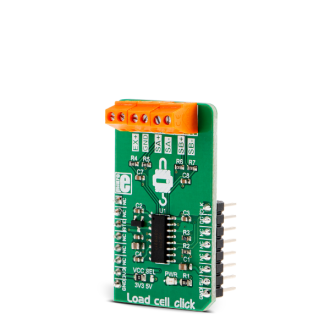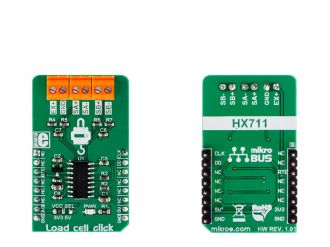
We strongly encourage users to use Package manager for sharing their code on Libstock website, because it boosts your efficiency and leaves the end user with no room for error. [more info]

Rating:
Author: MIKROE
Last Updated: 2019-11-14
Package Version: 1.0.0.0
mikroSDK Library: 1.0.0.0
Category: Force
Downloaded: 6706 times
Not followed.
License: MIT license
Load cell click is a weight measurement click which utilizes a load cell element, in order to precisely measure the weight of an object. The Load Cell click can be used with the strain gauge type of load cells and can measure up to ±20V or ±40V of differential voltage.
Do you want to subscribe in order to receive notifications regarding "Load cell click" changes.
Do you want to unsubscribe in order to stop receiving notifications regarding "Load cell click" changes.
Do you want to report abuse regarding "Load cell click".


Library Description
The library covers all the necessary functions to control Load cell click board.
Library reads 24-bit digital converted results from the desired channel with determined rate value (which determines the frequency of internal oscillator).
Key functions:
float loadcell_get_weight ( uint8_t input_sel, loadcell_data_t *cell_data ) - Function performs measurement.void loadcell_set_rate ( uint8_t rate_sel ) - Function selects the frequency of internal oscillator.void loadcell_set_mode ( uint8_t pwr_mode ) - Function puts the device in Power Up or Power Down Mode.Examples description
The application is composed of three sections :
void applicationTask()
{
weight_val = loadcell_get_weight( LOADCELL_CHANN_B_GATE_32_NEXT, &cell_data );
log_display( weight_val );
Delay_ms( 1000 );
}
Additional Functions:
void log_display ( float display_val ) - The function displays readings as a floating-point value with two decimal places.Other mikroE Libraries used in the example:
Additional notes and informations
Depending on the development board you are using, you may need USB UART click, USB UART 2 click or RS232 click to connect to your PC, for development systems with no UART to USB interface available on the board. The terminal available in all MikroElektronika compilers, or any other terminal application of your choice, can be used to read the message.